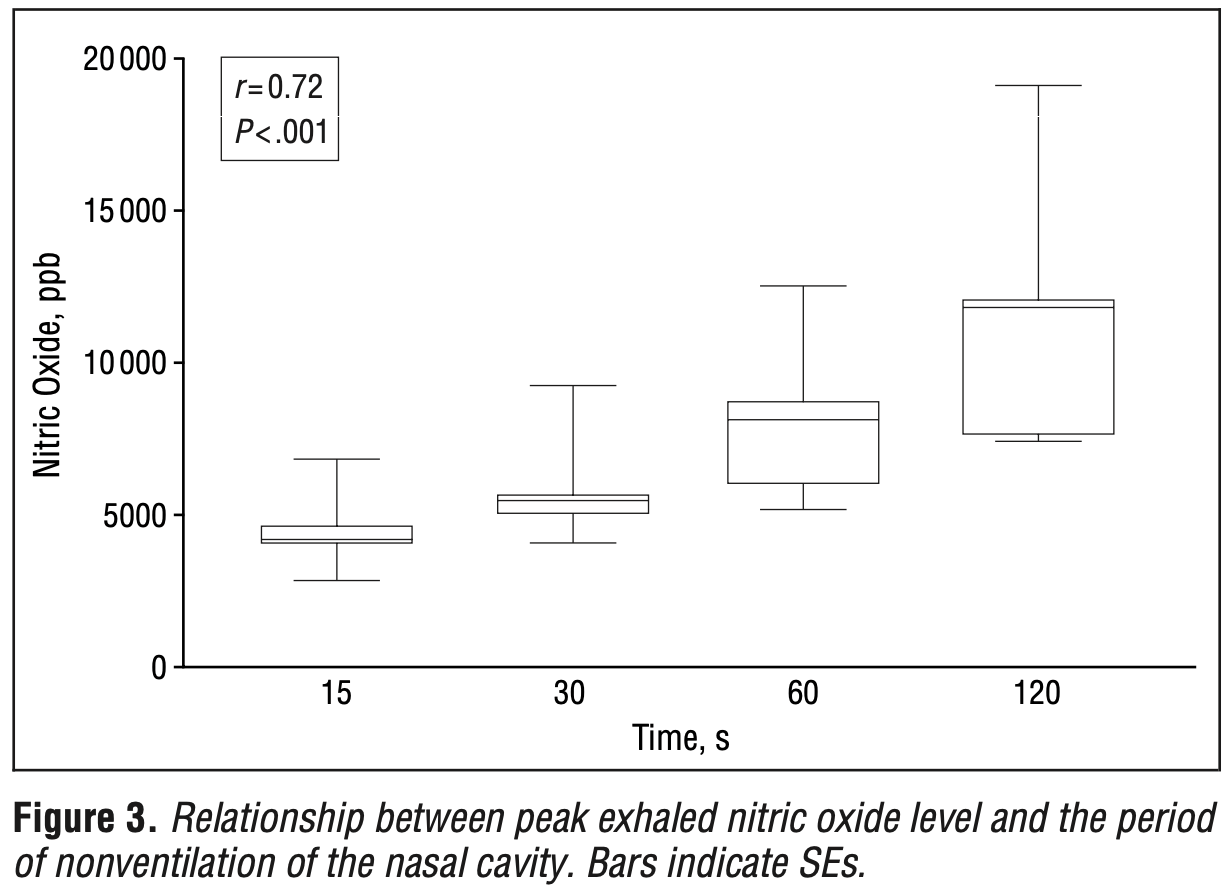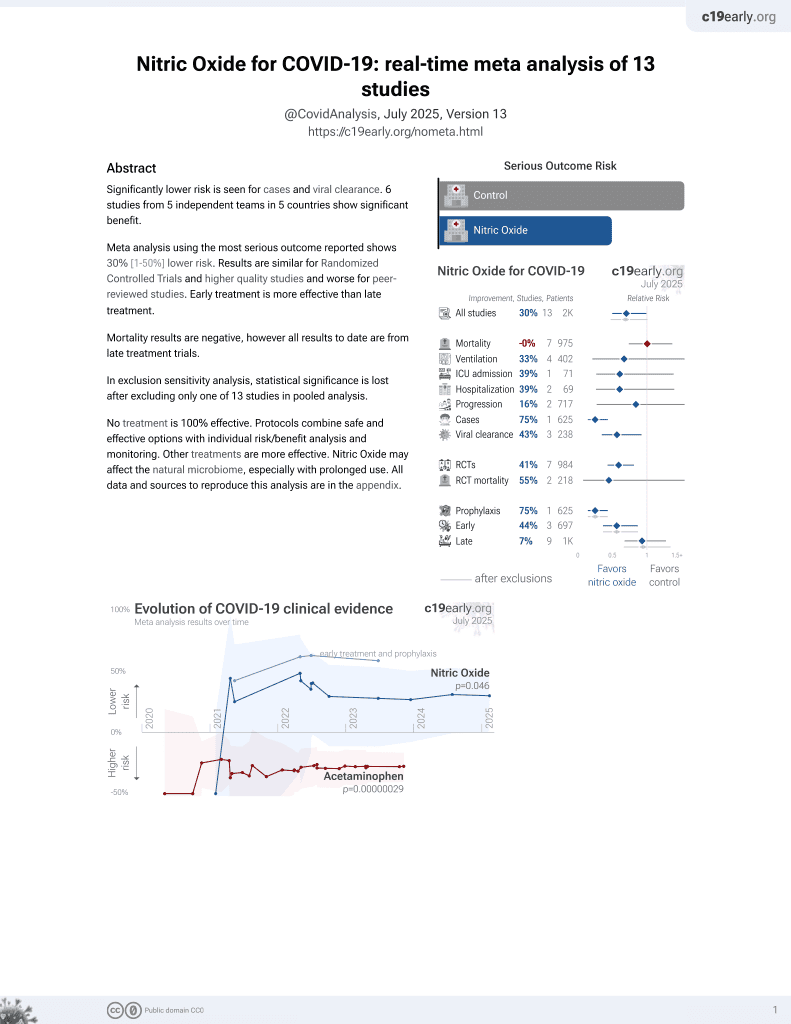
Nitric Oxide Accumulation in the Nonventilated Nasal Cavity
et al., Archives of Otolaryngology–Head & Neck Surgery, doi:10.1001/archotol.125.6.682, Jun 1999
42nd treatment shown to reduce risk in
June 2022, now with p = 0.046 from 13 studies, recognized in 10 countries.
Lower risk for cases and viral clearance.
No treatment is 100% effective. Protocols
combine treatments.
6,300+ studies for
210+ treatments. c19early.org
|
Analysis of nitric oxide concentrations in the nonventilated nasal cavity, showing increasing levels with time. Results indicate that nitric oxide levels can be increased with breathing techniques.
Chatkin et al., 1 Jun 1999, peer-reviewed, 6 authors.
Contact: jose.chatkin@utoronto.ca.
Nitric Oxide Accumulation in the Nonventilated Nasal Cavity
Background: Nasal nitric oxide is present in high concentrations in the upper airway relative to the lower respiratory tract. Objective: To explore the rate of nitric oxide accumulation in the nonventilated nasal cavity. Methods: In 9 healthy subjects previously trained to close the soft palate, steady-state plateau nitric oxide levels were recorded while air was aspirated through the nasal airway in series at a constant flow rate. Nitric oxide was then allowed to accumulate in the nasal cavity by occluding both nares and keeping the velum closed. After varying occlusion times, peak nitric oxide levels and a second plateau were ascertained. Results: While the subjects aspirated air at a constant flow, there was a slow rise to a first nitric oxide plateau.
References
Alving, Weitzberg, Lundberg, Increased amount of nitric oxide in exhaled air of asthmatics, Eur Respir J
Belvisi, Stretton, Yacoub, Barnes, Nitric oxide is the endogenous neurotransmitter of bronchodilator nerves in human airways, Eur J Pharmacol
Chatkin, Djupesland, Qian, Nasal nitric oxide is independent of nasal cavity volume, Am J Rhinol
Croen, Evidence for an antiviral effect of nitric oxide, J Clin Invest
Dillon, Hampl, Shultz, Rubins, Archer, Origins of breath nitric oxide in humans, Chest
Dubois, Douglas, Stitt, Mohsenin, Production and absorption of nitric oxide in the nose, J Appl Physiol
Furukawa, Harrison, Saleh, Shennib, Chagnon et al., Expression of nitric oxide synthase in the human nasal mucosa, Am J Respir Crit Care Med
Gerlach, Rossaint, Pappert, Knorr, Falke, Autoinhalation of nitric oxide after endogenous synthesis in nasopharynx, Lancet
Haight, Djupesland, Qian, Does nasal nitric oxide (NO) come from the sinuses?, J Otolaryngol
Imada, Iwamoto, Nonaka, Kobayashi, Unno, Measurement of nitric oxide in human nasal airway, Eur Respir J
Jain, Rubinstein, Robbins, Leise, Sisson, Modulation of airway epithelial cell ciliary beat frequency by nitric oxide, Biochem Biophys Res Commun
Kalender, Rettinger, Suess, Measurement of paranasal sinus ventilation by xenon-enhanced dynamic computed tomography, J Comput Assist Tomogr
Kharitonov, Rajakulasingam, Connor, Durham, Barnes, Nasal nitric oxide is increased in patients with asthma and allergic rhinitis and may be modulated by nasal glucocorticoids, J Allergy Clin Immunol
Leone, Gustafsson, Francis, Persson, Wiklund et al., Nitric oxide is present in exhaled breath in humans: direct GC-MS confirmation, Biochem Biophys Res Commun
Lindberg, Cervin, Runer, Nitric oxide production in the upper airways is decreased in chronic sinusitis, Acta Otolaryngol (Stockh)
Lundberg, Airborne nitric oxide: inflammatory marker and aerocrine messenger in man, Acta Physiol Scand
Lundberg, Nordvall, Weitzberg, Kollberg, Alvig, Exhaled nitric oxide in pediatric asthma and cystic fibrosis, Arch Dis Child
Lundberg, Weitzberg, Nordval, Kuylenstierna, Lundberg et al., Primarily nasal origin of exhaled nitric oxide and absence in Kartagener's syndrome, Eur Respir J
Lundberg, Weitzberg, Rinder, Calcium-independent and steroidresistant nitric oxide synthase activity in human paranasal sinus mucosa, Eur Respir J
Mancinelli, Mckay, Effects of nitric oxide and nitrogen dioxide on bacterial growth, Appl Environ Microbiol
Nijkamp, Folkerts, Nitric oxide and bronchial reactivity, Clin Exp Allergy
Nose, In: The Respiratory Role of the Upper Airways: A Selective Clinical and Pathophysiological Review: Volume and Surface of the Sinuses and Nasal Cavity
Paulsson, Bende, Larsson, Ohlin, Ventilation of the paranasal sinuses studied with dynamic emission computer tomography, Laryngoscope
Pelikan, The role of allergy in sinus disease: children and adults, Clin Rev Allergy Immunol
Zapol, Rimar, Gillis, Marletta, Bosken, Nitric oxide and the lung, Am J Respir Crit Care Med
DOI record:
{
"DOI": "10.1001/archotol.125.6.682",
"ISSN": [
"0886-4470"
],
"URL": "http://dx.doi.org/10.1001/archotol.125.6.682",
"author": [
{
"affiliation": [],
"family": "Chatkin",
"given": "Jose Miguel",
"sequence": "first"
},
{
"affiliation": [],
"family": "Qian",
"given": "Wei",
"sequence": "additional"
},
{
"affiliation": [],
"family": "McClean",
"given": "Patricia A.",
"sequence": "additional"
},
{
"affiliation": [],
"family": "Zamel",
"given": "Noe",
"sequence": "additional"
},
{
"affiliation": [],
"family": "Haight",
"given": "James",
"sequence": "additional"
},
{
"affiliation": [],
"family": "Silkoff",
"given": "Phillip",
"sequence": "additional"
}
],
"container-title": "Archives of Otolaryngology–Head & Neck Surgery",
"container-title-short": "Arch Otolaryngol Head Neck Surg",
"content-domain": {
"crossmark-restriction": false,
"domain": []
},
"created": {
"date-parts": [
[
2013,
6,
25
]
],
"date-time": "2013-06-25T16:50:26Z",
"timestamp": 1372179026000
},
"deposited": {
"date-parts": [
[
2014,
3,
10
]
],
"date-time": "2014-03-10T13:32:32Z",
"timestamp": 1394458352000
},
"indexed": {
"date-parts": [
[
2022,
12,
3
]
],
"date-time": "2022-12-03T08:08:49Z",
"timestamp": 1670054929103
},
"is-referenced-by-count": 17,
"issue": "6",
"issued": {
"date-parts": [
[
1999,
6,
1
]
]
},
"journal-issue": {
"issue": "6",
"published-print": {
"date-parts": [
[
1999,
6,
1
]
]
}
},
"language": "en",
"member": "10",
"original-title": [],
"page": "682",
"prefix": "10.1001",
"published": {
"date-parts": [
[
1999,
6,
1
]
]
},
"published-print": {
"date-parts": [
[
1999,
6,
1
]
]
},
"publisher": "American Medical Association (AMA)",
"reference-count": 0,
"references-count": 0,
"relation": {},
"resource": {
"primary": {
"URL": "http://archotol.jamanetwork.com/article.aspx?doi=10.1001/archotol.125.6.682"
}
},
"score": 1,
"short-title": [],
"source": "Crossref",
"subject": [
"General Medicine",
"Otorhinolaryngology",
"Surgery"
],
"subtitle": [],
"title": "Nitric Oxide Accumulation in the Nonventilated Nasal Cavity",
"type": "journal-article",
"volume": "125"
}
